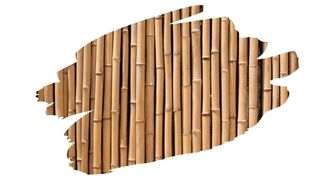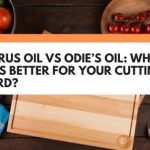Food prep and food safety should always go hand in hand. Yet the right coat of paint can seem like an easy way to give a bamboo cutting board some amazing color.
But, the problem with painting a cutting board, is that paint seals its surface. And this, in turn, prevents finishes from working effectively to protect that board.
So in this post, you will learn why painting cutting boards is rarely a good idea. You’ll also learn the difference between food-safe and food-grade finishes — and why it matters for food safety.
And keep reading to discover which natural food-safe paint is ideal for adding color to cutting board handles.

This post may contain affiliate links to products that we receive a commission for (at no additional cost to you). Learn more here.
What Kind Of Paint Do You Use On A Cutting Board?
First off, you should not apply a coat of paint to the surface of a cutting board.
Why? Well, because a cutting board surface will have direct contact with your food as you prep. And paint (even one’s classed as ‘food-safe’) aren’t meant to have direct contact with food.
What’s more, paint will seal over the pores of that cutting board surface. Which means that coat of paint will prevent finishes — such as mineral oil — from soaking down into that board.
Related Post: Can You Put Food Safe Epoxy Resin On Cutting Boards?
But I Want To Add Color To My Chopping Block…How Do I Do That?
Ideally, you would do this via material selection. For example, if you want a darker toned board, use darker wood types to make it.
Fact of the matter is painting a chopping board isn’t the best idea when it comes to food safety. However, if that cutting board is purely decorative, feel free to paint it how you like.
Otherwise, the only type of finish that should go on that chopping block is a food-grade one.
Wait A Minute…Food Grade And Food Safe Are The Same Thing, Right?
Not quite. You see, paints that are classed as food-safe often contain ingredients and resins that are not safe for us to consume.
But, these paints are perfectly fine (once they’ve wholly dried) to have coating surfaces in kitchens and dining rooms.
So That Should Mean That Food Safe Paint Is Fine For Cutting Boards Too?
Nope, not at all. And that’s because a food-safe paint is not wholly insurmountable.
Some types of paint can become damaged by alcohol or vinegar. And, failing that, they can easily become chipped by your sharp kitchen utensils.
So, if you coat a cutting board with paint, you’ll run the risk of that paint getting into your food. And those paint chemicals are the last thing you want mixing into your meal.
So What Kind Of Paint Do You Use On A Cutting Board?
You can use a food safe paint on the sections of the board that won’t have contact with food. And the most non-toxic food-safe paint you can use is milk paint.
Milk paint contains milk proteins, lime (aka calcium carbonate), and natural color pigments. All of which mean that this biodegradable matte paint is both natural and non-toxic.
Better yet, because its made from natural ingredients, it doesn’t release any eye-watering fumes either (unlike say acrylic paint).
But, the best thing of all about milk paint, is how easy it is to apply.
Milk paint doesn’t need a primer base coat. Instead, you can brush this paint onto cutting board handles, and it’ll adhere with ease.
Related Post: Is There A Food Safe Paint For Wood?
And How Do You Seal A Bamboo Cutting Board Afterward?
Use pure food grade mineral oil to finish off that chopping block. Made from refined petroleum distillate, this non-toxic non-drying oil will sink right down into most any porous surface.
Now, this oil isn’t as durable as other finishes — as it is a non-drying oil. Yet it still works fantastically well at making cutting boards very water-repellent.
Nevertheless, you will need to reapply it regularly — roughly every 1-3 weeks depending upon frequency of washes.
Food grade mineral oil can be purchased at almost any local pharmacy or grocery store.
To Wrap Up, Here Are The 3 Key Takeaways From This Post…
- 1). If you plan on using your cutting board for food prep, you should not paint the surface of it. Paint will seal over the cutting board, making it difficult to finish afterwards.
- 2). You can paint the non-food-contact parts of cutting boards (such as the handles) with a food-safe paint.
- 3). The best way to seal a bamboo cutting board is by saturating it with pure food-grade mineral oil.



